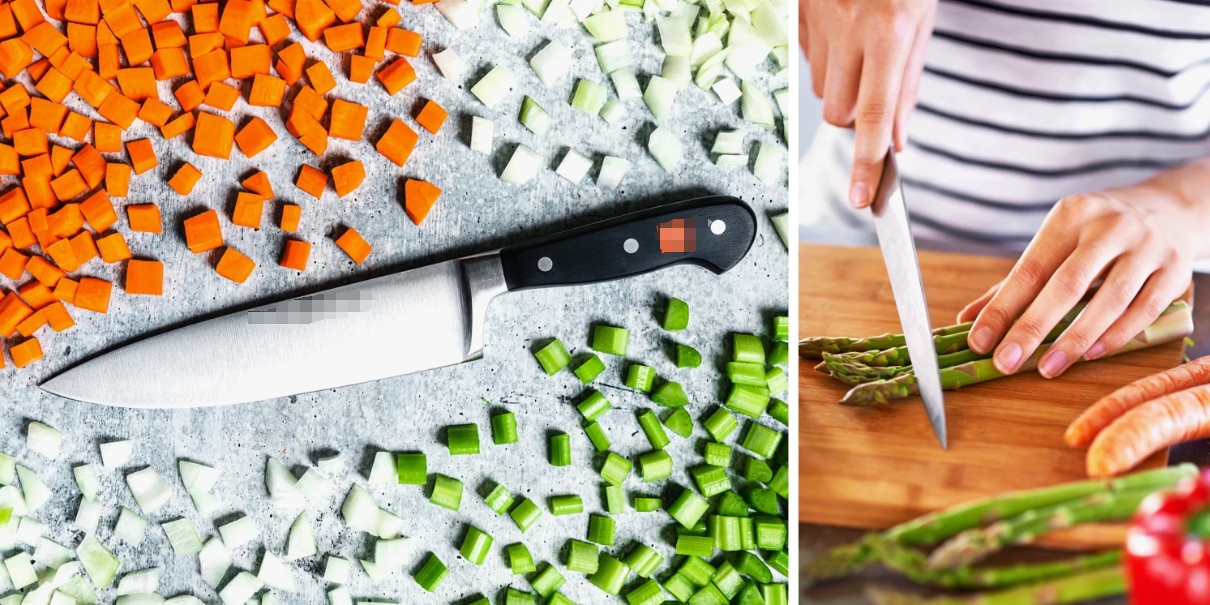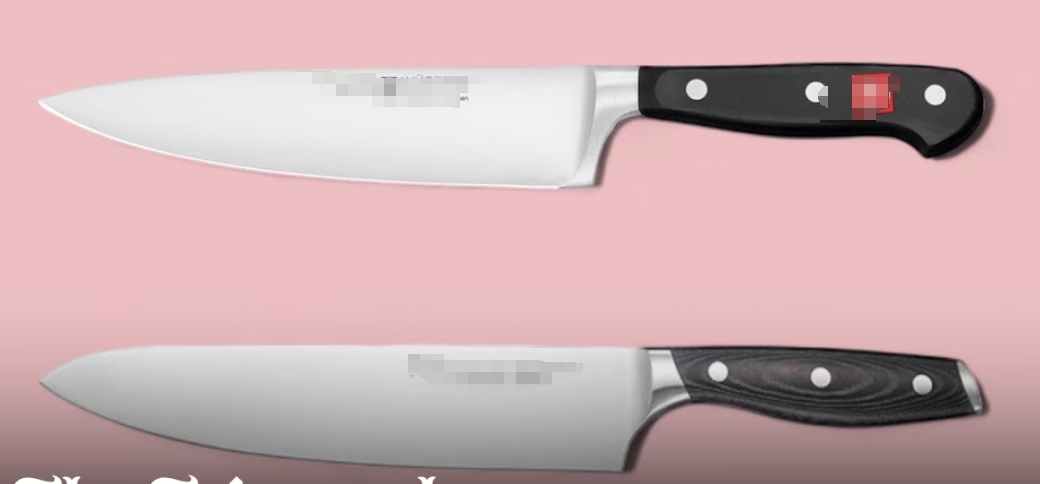

Views: 222 Author: Ella Publish Time: 2025-04-17 Origin: Site








Content Menu
● Why a Good Chef Knife Matters for Beginners
● Key Features to Look for in a Beginner Chef Knife
>> Blade Material and Sharpness
>> Blade Length
>> Handle Comfort and Material
● Top Chef Knives Recommended for Beginners
>> 1. Mercer Culinary Genesis 8-Inch Chef's Knife
>> 2. Victorinox Swiss Classic 8-Inch Chef's Knife
>> 3. Wüsthof Classic 8-Inch Kitchen Knife
>> 4. MAC MTH-80 Professional 8-Inch Chef's Knife
>> 5. Mercer Culinary Millennia 8-Inch Chef's Knife
● Understanding Different Chef Knife Styles
>> Western (German) Style Chef Knives
● Essential Knife Skills for Beginners
>> Safety Tips
● FAQ
>> 1. What size chef knife is best for beginners?
>> 2. Should beginners choose a Japanese or German style chef knife?
>> 3. How do I know if a chef knife is comfortable?
>> 4. How often should I sharpen my chef knife?
>> 5. Can I use one chef knife for all kitchen tasks?
Choosing the right chef knife is a crucial step for anyone starting their culinary journey. A good chef knife not only makes food preparation more efficient but also safer and more enjoyable. This comprehensive guide explores the best chef knives for beginners, covering essential features, top recommendations, knife skills, and maintenance tips to help you confidently select and use your first chef knife.

A chef knife is the most versatile and frequently used tool in the kitchen. For beginners, having a knife that feels comfortable, balanced, and sharp can transform cooking from a daunting task into a pleasurable experience. A quality chef knife helps you:
- Cut ingredients more precisely and efficiently
- Reduce the risk of accidents due to slipping or dull blades
- Build confidence in your knife skills and cooking techniques
Having the right knife can also encourage better cooking habits. When your knife feels like an extension of your hand, you naturally develop smoother, safer cutting techniques. This reduces frustration and increases your enjoyment in the kitchen. For beginners, this positive reinforcement is invaluable.
When shopping for your first chef knife, consider these important features:
The blade material directly impacts the knife's sharpness, durability, and maintenance needs.
- High-carbon stainless steel is ideal for beginners because it combines sharpness with rust resistance and easier maintenance. This material resists stains and corrosion better than traditional carbon steel while still holding a sharp edge.
- Japanese knives tend to have harder steel that stays sharp longer but may chip if misused. These knives often require more careful handling and maintenance but reward users with exceptional precision.
- German-style knives are usually softer but more durable and forgiving for heavy-duty tasks. They can withstand more abuse, making them a practical choice for novices.
Blade length affects control, versatility, and comfort.
- An 8-inch blade is the most versatile size for beginners, offering enough length for large vegetables but still manageable for most hand sizes. It strikes a balance between precision and power.
- Smaller blades (6-7 inches) can be good for those with smaller hands or for more precise tasks but may limit versatility. Larger blades (9-10 inches) are often more suited for experienced cooks and professional chefs.
The handle is where you connect with your knife, so comfort is paramount.
- Ergonomic handles that fit comfortably in your hand reduce fatigue and improve control during extended use.
- Handle materials vary from Santoprene (a rubber/plastic composite), wood, to resin composites. Santoprene handles offer good grip and durability for beginners, especially in wet or greasy conditions.
- Wooden handles provide a traditional feel and aesthetic but may require more care to prevent cracking or warping.
- Avoid handles that feel too chunky or slippery, as they increase the risk of accidents.
- A full tang means the blade extends through the handle, providing better balance and durability. Knives with full tangs tend to feel more stable and less prone to breaking.
- Balanced knives feel like an extension of your hand and make cutting safer and easier. When a knife is well balanced, the weight distribution allows for smoother cuts and less strain on the wrist.
- A full bolster protects fingers and offers a secure grip, which is helpful for beginners learning to control the knife. It also adds weight near the handle, improving balance.
- Semi-bolsters or no bolster knives offer more control for experienced users but may feel less safe for novices. If you are just starting, a knife with a full bolster can provide an extra margin of safety.
Mercer Culinary Genesis is a favorite among culinary students and home cooks alike. Its high-carbon stainless steel blade offers excellent edge retention and corrosion resistance. The Santoprene handle is slip-resistant and comfortable, making it ideal for beginners who may be less confident handling knives. The full tang ensures good balance, and the knife is versatile enough to handle most kitchen tasks, from chopping vegetables to slicing meat.
Victorinox is renowned for producing reliable, affordable knives. The Swiss Classic 8-inch chef's knife features a razor-sharp high-carbon stainless steel blade with a lightweight, ergonomic handle. Its finger guard enhances safety, and the knife's overall balance makes it easy to control. This knife is often recommended as the best budget option for beginners, delivering professional performance without breaking the bank.
Wüsthof is a premium German brand known for its forged knives. The Classic 8-inch chef's knife has a full tang forged from a single piece of high-carbon stainless steel, ensuring durability and excellent edge retention. The handle is made from durable synthetic material shaped for comfort. While heavier than some other knives, its balance and sharpness make it a worthwhile investment for beginners planning to cook regularly.
The MAC MTH-80 is a Japanese-style chef knife that combines a thin, razor-sharp blade with a Western-style handle, making it accessible for beginners who want precision slicing. The blade is made from high-quality alloy steel and is lighter than many German knives, reducing hand fatigue. It requires more maintenance to prevent rust but rewards users with exceptional sharpness and control.
The Mercer Millennia is a stamped blade knife, meaning it's cut from a sheet of steel rather than forged. While this usually means less durability, this knife is surprisingly sharp and affordable, making it a great starter knife for home cooks on a budget. Its Santoprene handle offers a secure grip, though it is a bit chunkier than other models.

Western-style chef knives typically feature thicker, heavier blades designed for chopping, slicing, and heavy-duty kitchen tasks. They are made from softer steel, which means they require more frequent sharpening but are less prone to chipping. The full bolster and heavier handle provide excellent balance and durability, making these knives forgiving for beginners.
Japanese chef knives are known for their thin, lightweight blades made from harder steel. This allows for incredibly sharp edges and precise cuts, ideal for delicate slicing and fine dicing. However, the harder steel can be more brittle, so these knives require careful handling to avoid chipping. Japanese knives often have smaller or no bolsters, which can feel unfamiliar to beginners but offer more control for experienced users.
Santoku and Nakiri knives are Japanese-style knives that are excellent alternatives for beginners who want something less intimidating than a traditional chef knife.
- Santoku knives typically have a shorter blade (5-7 inches) with a granton edge (scalloped indentations) that reduces food sticking to the blade. They excel in slicing, dicing, and mincing.
- Nakiri knives have a straight edge and are designed specifically for chopping vegetables. Their thin, flat blade allows for clean cuts through produce without rocking.
Both Santoku and Nakiri knives are lighter and easier to control, making them ideal for beginners with smaller hands or those focusing on vegetable prep.
Mastering basic knife skills will help you get the most out of your chef knife and keep you safe in the kitchen.
- Use a pinch grip: Pinch the blade between your thumb and forefinger just in front of the bolster. This grip offers maximum control and stability.
- Wrap your remaining three fingers around the handle comfortably. Avoid holding the knife too tightly, which can cause fatigue.
- Rocking motion: Keep the tip of the blade in contact with the cutting board and rock the knife up and down to chop herbs, onions, and other small items. This technique is efficient and safe once mastered.
- Slicing motion: For clean cuts, especially on vegetables like tomatoes or meats, use a forward and backward sliding motion rather than pressing straight down. This preserves the integrity of the food and the sharpness of your blade.
- Always keep your knife sharp. Dull knives require more force and are more likely to slip, increasing the risk of injury.
- Use a stable cutting board made of wood or plastic. Avoid glass or marble, which can dull your blade.
- Practice the claw grip with your guiding hand: curl your fingertips inward and use your knuckles as a guide for the knife. This keeps your fingers safe.
- Cut slowly and deliberately when learning new techniques. Speed will come with practice.
Proper care extends the life of your chef knife and keeps it performing well.
- Hand wash only: Avoid dishwashers, which can damage the blade and handle. Use mild soap and warm water, then dry immediately to prevent rust.
- Storage: Store knives in a knife block, on a magnetic strip, or in blade guards to protect the edge and prevent accidents.
- Honing: Use a honing steel regularly (every few uses) to realign the blade edge and maintain sharpness between sharpenings.
- Sharpening: Depending on use, sharpen your knife every 6 to 12 months. You can use a whetstone, sharpening system, or professional sharpening services. Avoid pull-through sharpeners as they can remove too much metal and damage the blade.
For beginners, the best chef knife is one that balances sharpness, comfort, and ease of use. An 8-inch high-carbon stainless steel knife with a full tang and ergonomic handle is generally the ideal choice. Budget-friendly options like the Victorinox Swiss Classic and Mercer Culinary Genesis offer excellent performance, while knives like the Wüsthof Classic and MAC MTH-80 provide premium quality for those ready to invest more. Learning proper knife skills and maintaining your knife will enhance your cooking experience and safety. With the right knife and technique, you'll be well on your way to mastering the art of cooking.

An 8-inch blade is the best size for most beginners because it is versatile enough for a wide range of kitchen tasks without being too bulky or unwieldy.
Beginners often prefer German-style knives for their durability and forgiving nature, but Japanese knives are excellent for precise slicing if you are willing to maintain them carefully.
Comfort depends on handle shape, material, and balance. The best way is to hold the knife and see if it feels like an extension of your hand and doesn't cause fatigue during use.
Sharpen your knife when you notice it becoming dull, typically every 6 to 12 months for home cooks. Regular honing every few uses helps maintain the edge longer.
Yes, a good 8-inch chef knife can handle about 90% of kitchen cutting tasks, including chopping, slicing, dicing, and mincing.
[1] https://www.seriouseats.com/the-best-chefs-knives
[2] https://www.istockphoto.com/illustrations/chef-knife
[3] https://www.youtube.com/watch?v=YrHpeEwk_-U
[4] https://www.goodhousekeeping.com/cooking-tools/best-kitchen-knives/g646/best-kitchen-cutlery/
[5] https://www.surlatable.com/o?c=beginner-chef-knives
[6] https://www.youtube.com/watch?v=-al-bs737fw
[7] https://www.nytimes.com/wirecutter/reviews/the-best-chefs-knife-for-most-cooks/
[8] https://www.curated.com/journal/2698000/an-expert-guide-to-chef-s-knives-how-to-buy-the-best-chef-knife-for-you
[9] https://www.vecteezy.com/free-photos/chef-knife
[10] https://www.youtube.com/watch?v=FNuV7lg6jgg
[11] https://www.epicurious.com/expert-advice/best-chefs-knife-article
[12] https://www.youtube.com/watch?v=Gl1wLtpdpKs
[13] https://cookprimalgourmet.com/blog/chefs-knife-buying-guide/
[14] https://www.youtube.com/watch?v=os8xnwxcHg0
[15] https://nymag.com/strategist/article/best-chefs-knives.html
[16] https://www.eater.com/24364456/best-chefs-knives
[17] https://www.foodandwine.com/lifestyle/kitchen/best-chefs-knife
[18] https://www.telegraph.co.uk/recommended/home/kitchen/best-chefs-knives/
[19] https://www.allrecipes.com/affiliate/best-chefs-knives/
[20] https://www.chefscomplements.co.nz/general/knives/the-best-knife-guide/
[21] https://www.istockphoto.com/photos/chef-knife
[22] https://stock.adobe.com/search?k=chef+knife
[23] https://stock.adobe.com/search/images?k=chef+knife+drawing
[24] https://www.youtube.com/watch?v=QgVyN6Lpiuc
[25] https://www.tophamknifeco.com/best-youtube-videos-on-how-to-make-a-chef-knife/
[26] https://www.youtube.com/watch?v=OYOtX4y-iCw
[27] https://www.youtube.com/watch?v=vpwL9y76rOo
[28] https://www.youtube.com/watch?v=YeXlocfenf8
[29] https://www.reddit.com/r/chefknives/comments/rf8ml1/beginners_guidefaq/
[30] https://chefjulieyoon.com/2020/04/the-ultimate-knife-guide-for-the-home-cook/
[31] https://seisukeknife.com/pages/beginners